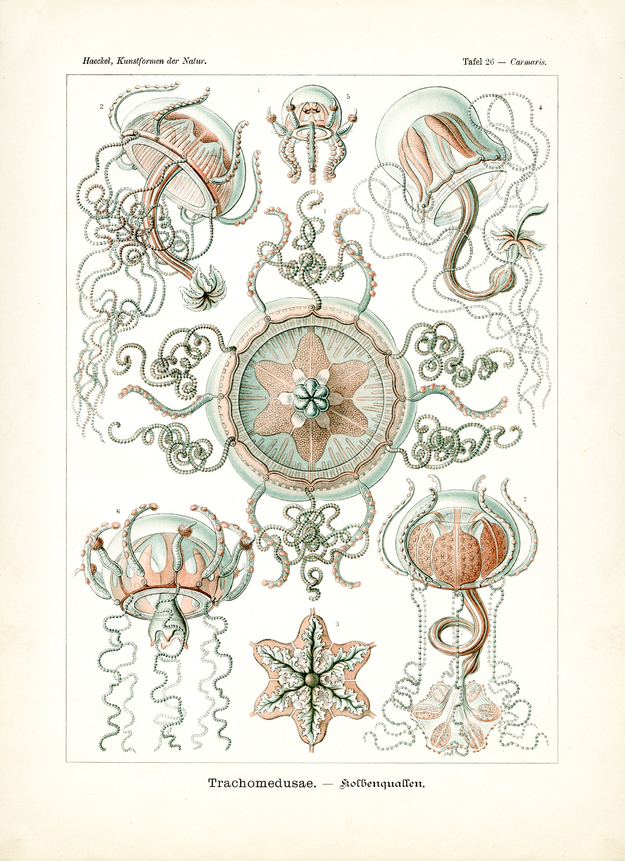Trachomedusae (Kolbenquallen) form a special order within the subclass of Craspedotae or Hydromedusae (Hydrozoans), closely related to the order of Narcomedusae (Spangenquallen, plate 16). Just like the latter they have characteristic ‘hearing buds’ located at the rim of the gelatinous umbrella, which are at times free, at times enclosed in ‘hearing bubbles’. However, Gonads are not resting in the lower stomach wall (as in the Narcomedusae, table 16) but along the course of the ‘jet canals’ that run at the rim of the central gastrovascular cavity along the lower umbrella plane towards the rim of the gelatinous umbrella where they are connected with the help of a ‘ring canal’. Other ‘food canals’ enter from this ‘ring canal’ into the flexible tentacles or ‘capturing threads’ which sit along the rim of the umbrella and are armed with ‘nettle organs’.
Geryonidae (Rüsselquallen), illustrated on this plate, form an extremely interesting family within the order of Trachomedusae, distinguished by leave-shaped Gonads, the peculiar structure of the big ‘hearing bubbles’ enclosed in the gelatinous mass of the rim of the umbrella, and the long stomach shaft that hangs down from the centre of the lower umbrella plane like a snout. At the lower end of this flexible trunk the small, bell-shaped stomach is located with a mouth opening that is divided into four or six leave-shaped, very tensile lopes. Four or six ‘tube canals’ rise on the outer surface of the snout towards the sub-umbrella (the lower, hollow umbrella plane) and bend here towards the rim of the umbrella where they unite in the ‘ring canal’. Frequently blind ‘centripetal canals’ return from the latter towards the centre (fig. 1 and 2). Geryonids possess two different forms of tentacles that sit at the rim of the umbrella. Four or six rigid and solid tentacles are bent upward, armed on the outer side with ‘nettle pads’. Tentacles as long, hollow and flexible alternate regularly with them, usually hanging down, often bundled and belted with the help of numerous ‘nettle rings’ like a string of beads.
Geryonidae are vividly versatile, and they are dangerous predators in spite of their tender, transparent body structure; some species belong to the most formidable Craspedotae (with an umbrella diameter of 10 cm and more). Many species are colourless, vitreous; others are of tender blue, greenish or reddish colouration. On our plate the gelatinous substance of the body is coloured in greenish blue, canal system and nettle organs are reddish. – All Geryonids illustrated here belong to the subfamily of Carmarinidae with a six-jetted body structure; the subfamily of the smaller Liriopidae shows a four-jetted structure as most of the other Medusae.
Translation of the original German introduction by Ernst Haeckel:
Phylum of Cnidaria (Nesseltiere); - subclass of Craspedotae (Schleierquallen); - order of Trachomedusae (Kolbenquallen); - family of Gerynidae (Rüsselquallen).
Translation by VR Translators Bangalore
This is one of the 100 pop science biology illustrations that were published from 1899 – 1904 in Leipzig by Ernst Haeckel through Verlag des Bibliographischen Instituts.
We've scanned the original lithography at 1200dpi on the Epson A3 scanner of A3 scanner huren. You can download a 400dpi JPEG here.
